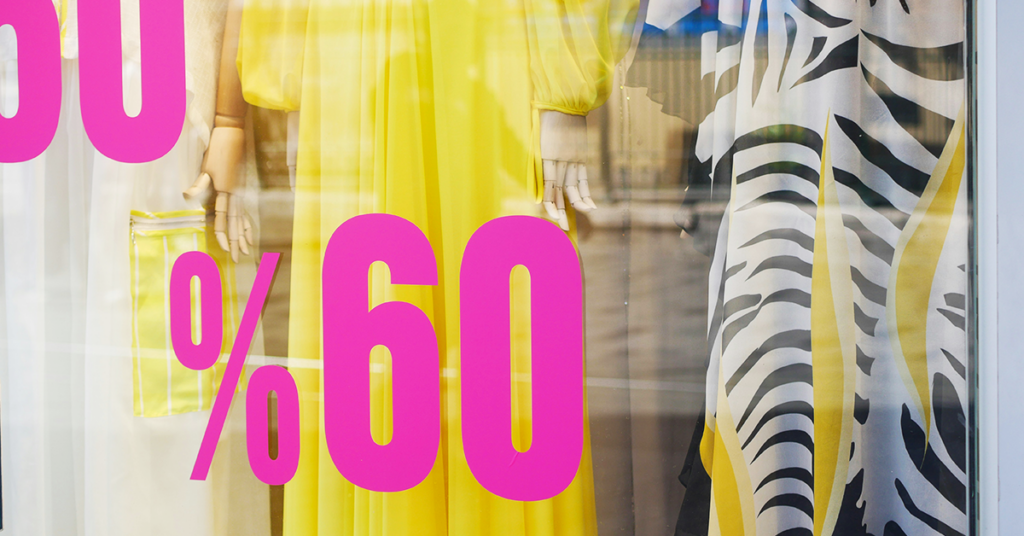Black Friday is coming up, and you figure it’s probably time to replace your one dependable pair of mid-wash jeans. But as you’ve started weighing up options for a new pair, you’ve also landed on a few mailing lists—and the notifications keep rolling in. The targeted ads you usually see between reels of unlikely pairings of adorable animals have also become increasingly fashion-centric.
Then cyber-sales kick off as you’re scrolling on the commute home. You see a reminder for those jeans you’ve been mulling on, along with suggestions from a brand you recently followed. Suddenly you find yourself clicking to confirm purchase on a bunch of things you hadn’t bargained on.
Happiness Is A New Pair Of Pants
Try not to be too hard on yourself if you’ve ever found yourself in this position. Decades of research into consumer psychology has shown there are actually a huge number of unconscious factors that affect how we shop.
There’s a reason we take comfort in ‘retail therapy’. Studies suggest that shopping can reduce sadness and give us a sense of control. MRI scans of consumers have revealed that even simply contemplating a purchase leads to the release of dopamine. We also tend to get an even bigger dose of dopamine when our purchases lead to an ‘unexpectedly good’ reward. No wonder sales excite us!
Considering product cost however activates the pain pathways in our brain. Researchers refer to the way we mentally negotiate the pain and reward of purchases as affective forecasting. Unfortunately, our predictions are not often all that realistic as depending on past experience, our state of mind, or the way a product is advertised, we tend to idealise the potential benefit of a purchase before we take conscious action.
Mindful Marketing
Today’s market researchers have a sophisticated understanding of how to capitalise on our unconscious tendencies through advertising. By applying techniques commonly used in neuroscience companies can reliably predict and influence our purchasing behaviour.
Brands can use tools like MRIs to measure the way advertisements affect brain activation, heart rate or eye movement in consumers, using these metrics as an indication of whether their products excite us or grab our attention. This information can then be used to sharpen the appeal of everything from product styles and colours to prices and storefronts. Modern smartphones can even capture some of this feedback in real time, and digital storefronts can easily be remade based on how we interact with different websites and apps. This makes the prospect of ‘thoughtful’ consumption especially fraught now that online shopping has become the norm and an enormous array of products are only a click away.

Feed Fatigue
Research on another behaviour called comparative valuation has shown that even when we are mentally at our best, we have trouble assessing several products at once. As soon as we have to decide between any more than two shirts or sweaters at a time, we are much more likely to pick one based on how it compares to others in the sample, rather than on individual merit.
Product groups like this are then embedded alongside all the other content we scroll, based on the data that we provide through social and sales platforms. What does that do to our brains? Studies have shown that as little as thirty seconds of social media exposure can leave us in a state of cognitive overload. And aided by algorithms, brands can now ensure we are presented with curated selections of products as we scroll, where certain items appear obviously attractive next to a bunch of duds. Researchers call this the decoy effect, and the mental burden of social-media use can leave us particularly susceptible to making impulsive purchases under its influence.
Taking the Long View
So how can we shift the narrative and make more informed choices when we shop? Don’t get me wrong, shopping online is incredibly convenient! It is however important to understand that our innate desire for a dopamine-rush will often override our ability to consider the long-term impact of our purchases during a Black Friday sales rush.
And there are real impacts. With the recent growth of ultra-fast-fashion, excesses in the production and disposal of garments are leading to the creation of 92 million tonnes of global textile waste per year. And as our latest Ethical Fashion Report highlights, while fashion companies have been increasing their production in response to consumer demand, 89 per cent of companies still aren’t paying a living wage at any facility in their supply chain.
What Can I Do?
These figures might seem alarming—and they should! Excess production & disposal of textiles is putting enormous strain on global ecosystems and the lives of garment workers. But don’t let stats or sophisticated marketing tactics discourage you.
By making a few simple adjustments to our behaviour, we can encourage positive change through individual action.
Here are a few suggestions to help you minimise your waste footprint and shop with more intention:
1. Stop, think, reflect
Before you throw yourself into researching a new shirt or skirt to grab during a flash sale, it’s worth stopping to reflect on what you already have. Micro-trends have become increasingly prevalent, with brands introducing small stylistic variations to wardrobe staples to encourage consumers to pick up new items. Fashion however, as they say, comes in cycles. You might be surprised to find after taking stock that you already own a few great pieces.
And even if you don’t have the right thing on hand, someone else might! Hosting a clothing swap is a great way to connect with friends and give your clothes a new lease on life!
It’s also always worth stepping away from a purchase decision once you’ve spent some time weighing it up. A good night’s sleep can be the difference between a hasty decision you might regret, and feeling satisfied that you’ve made a considered call.
2. Limit your exposure
Most brands will automatically add you to a mailing list any time you fill out a form. So another practical way to limit unnecessary purchases is to limit the messages that prompt them by unsubscribing from marketing emails and turning off notifications for apps that deliver product reminders.
Social media may be a little more difficult to avoid altogether, especially for those whose daily lives depend on it. If however you’re looking to mitigate social media’s impact on your life during a sales period, you can always try introducing device-use limits on specific apps or websites.
3. Let your values lead
Of course, we all need some fresh clothes sometimes. If you’re in this position you could search local second-hand retailers first. That way you won’t be contributing to waste or excess demand, and you’ll probably save a few bucks in the process.
If you do end up buying new, it’s worth considering where you buy it from. Investing in companies that are acting ethically and practicing responsible resource stewardship will help to ensure that your purchases aren’t negatively impacting people or the planet. Our newest Ethical Fashion Guide provides an easy way to look up which brands are doing their part to minimise environmental harm and support the lives of their workers.
A Model For Change
The more we understand our unconscious shopping behaviours, the better equipped we will be to navigate the pitfalls of the digital spaces that reinforce them. And if we can manage to disengage from these environments and structures, we might be able to free up the mental resources to develop a new relationship with consumption—one that doesn’t rely on constant demand. By acting thoughtfully and with greater intention, we can play a key part in reducing the impact of over-production and consumption on the planet and those around us.



 Katherine Halliday,
Katherine Halliday,

 Sophia Russell,
Sophia Russell,